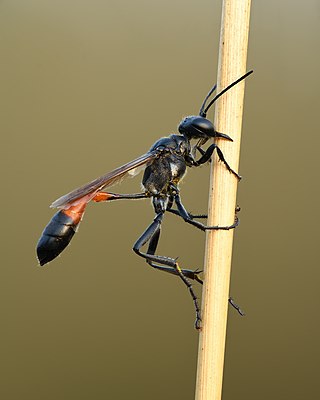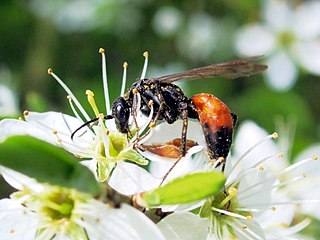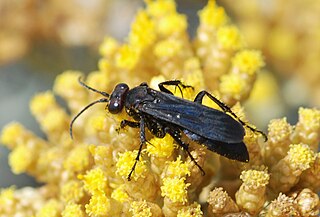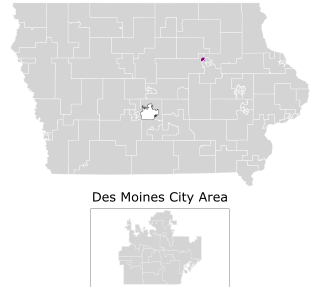
The Sphecidae are a cosmopolitan family of wasps of the suborder Apocrita that includes sand wasps, mud daubers, and other thread-waisted wasps.

Pierre Léonard Vander Linden was a Dutch entomologist.

De Mens is a Flemish rock band from Belgium. The current members of the band are Frank Vander linden, Michel de Coster, and Dirk Jans.

Pachycondyla is a ponerine genus of ants found in the Neotropics.

Episyron is a genus of wasps in the family Pompilidae which prey on spiders. Nine species are found in Europe.

Anoplius is a genus of spider wasps in the family Pompilidae called the blue-black spider wasps. It is one of two genera within the tribe Anopliini of subfamily Pompilinae.

Cryptocheilus is a genus of spider wasps of the subfamily Pepsinae, found in the world's warmer regions. They vary in size from medium to large and are often strikingly coloured. The females construct multicellular nests in cavities, once built each cell is stocked with a spider, captured by the female. They are found in open habitats such as heaths, meadows and forest edges.

Aporus unicolor, common name cutpurse, is a highly specialised spider hunting wasp from the family Pompilidae.

Priocnemis is a genus of pepsine spider wasp containing around 30 species.

Evagetes is a genus of spider wasps from the family Pompilidae. There are 72 described species, of which 58 are found in the Palaearctic region, 11 in the Nearctic region, with a few penetrating to the Afrotropical, Oriental and Neotropic regions. Evagetes wasps are kleptoparasitic on other pompilid wasps, especially the genera Arachnospila, Anoplius, Episyron and Pompilus, digging into their sealed burrows, eating the host egg and replacing it with an egg of its own. Evagetes wasps are characterised by their very short antennae. Most are species are black with the base of the antennae rufous, several Evagetes species are very metallic bluish insects.

Agenioideus is a genus of spider wasps from the subfamily Pompilinae; the genus occurs in Europe, where 21 species are recorded, eastwards to Japan, in North America, South America, and Australia.
Van der Linden is a Dutch toponymic surname meaning "from the linden tree". It can also be spelled Vander Linden or Vanderlinden. Notable people with the surname include:

Guy Vander Linden is an American politician of the Republican Party serving as a member of the Iowa House of Representatives for the state's 84th district. He was elected to his first term in office in 2010.

Crossocerus is a genus of square-headed wasps in the family Crabronidae. There are at least 250 described species in Crossocerus.

Mimumesa is a genus of wasps in the family Psenidae. The species are found in the Holarctic. 32 species are known to exist.
Anoplius infuscatus is a species of spider wasp found mainly in Eurasia.

The 75th District of the Iowa House of Representatives in the state of Iowa. It's currently composed of part of Black Hawk County.
Herman Vander Linden (1868–1956) was a Belgian historian who was a professor at the University of Liège.

Apis mellifera unicolor is known by the common name of the Madagascar honey bee, sometimes also called the Malagasy honey bee. It is endemic to the island of Madagascar.















